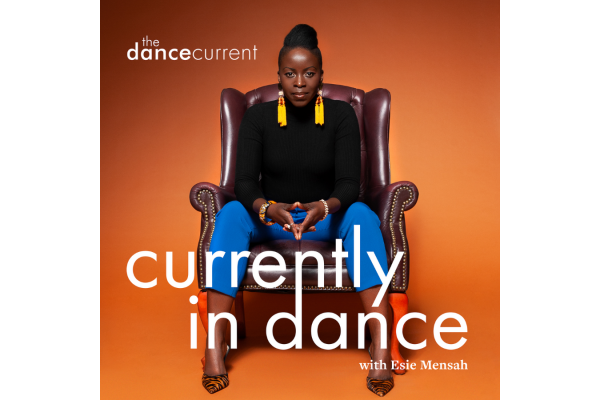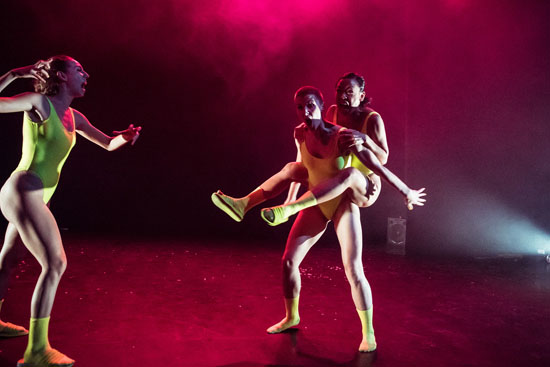Launching on June 16, Currently in Dance is The Dance Current‘s new summer podcast. On the show, you’ll hear rich conversations about the issues affecting dance communities and society at large. Continue reading an excerpt from our first episode, featuring Mavis Staines, the artistic director and CEO of Canada’s National Ballet School, on systemic issues within educational institutions and what real change looks like. You can find Currently in Dance on thedancecurrent.com and wherever you get your podcasts.
Esie Mensah: Mavis, thank you so much for joining me.
Mavis Staines: Oh, it’s my pleasure.
EM: You have developed this incredible legacy as artistic director of NBS since 1989. The school has been working for a number of years in Equity, Diversity and Inclusion prior to the racial reckoning during the start of the pandemic. Not every student who has walked through those doors has had a positive experience. Why was it important for you to see the school genuinely evolve?
MS: I think that it’s always been a priority to see this goal evolve. I just wasn’t looking broadly enough. When I was offered the opportunity, what really attracted me was the chance to make systemic changes within an art form, a process that I love passionately. But right from my years as a student, I could see that there were traditions that were sometimes not only counterproductive but abusive. So to have a chance to shift those has been a life gift. It’s been really meaningful. In the last five years and then since the pandemic, I thought, my goodness, the blinkers have been lifted now, and clearly, everything that’s happened since 1989 has been an opportunity to practise and say, Now it’s the really, really deep work of advancing equity.
EM: In our intro, we played a clip of you talking about how some of the traditions and ballet schools you have seen were counterproductive, as you just mentioned. Can you give us an example of what that might be?
MS: Absolutely. I think [that] far too often ballet dancers have been educated in a way where they have been discouraged to develop their own voice and to be true to their own values. So it was really, really important to me that there be ways that ballet dancers be educated to be equal creative partners. And also that there is the shift from ballet only being about bodywork, and somehow a perfect body, that it was time to acknowledge that the body is the symphony orchestra with which one conveys the language of ballet and dance. The second thing is that so much of the feedback to ballet dancers has become solely about bodywork, and the body is the vessel. But it’s how you use your symphony orchestra. So it’s been really pushing to say, Let’s talk about what is actually the pulse and the force of ballet and dance rather than getting lost in the framework, as opposed to looking at what’s within the framework.
EM: What are some of the ripple effects that have manifested [from this work] beyond community programming?
MS: Oh, that’s a great question. It’s one that I asked myself all of the time. It helps me when I pause and think, OK, what has been the time frame in which this has become so bodyfocused? And I really think that it’s been since the mid-1970s that it’s become increasingly like that. Because if you look at ballet companies prior to that, there was a lot more diversity of look and a lot more focus on the movement and what it was dancers were conveying. But I think, in a bizarre and unfortunate way, [with] the explosion of ballet’s popularity in the 1980s with Nureyev and Baryshnikov and Makarova and the mystique around that, it became so popular that there was then this filtering of who was suitable and who wasn’t suitable, based solely on how they looked rather than what they were bringing to the language. So I think it was the richness of popularity that created the beginning of this narrowing, which now, if we don’t open it up, I really think it puts ballet at risk.
EM: What do you think [is] the impact of the students finding their voice? What do you see as a potential long-term ripple? In a way, it’s beautiful to see the students start to have agency. And so what does that mean for students, for teachers, that are not necessarily used to working in this way?
MS: I think one of the things that you bring to the students, and I know I strive to do the same, as do our colleagues, [is] that this is about being accountable in the best possible sense of the word, not looking for any of us to be perfect because that doesn’t exist. But if you can own when you realize that you’ve made a choice that you won’t make again, and that you’ve learned from it, then everybody feels safe to be human. And I think that that is a big piece of this. And what I also love is that the changes within NBS are, without a doubt, going to have a huge and important impact on ballet because we’ve seen the impact that alumni have on ballet and on dance and then in the world beyond dance. So I think that as we measure the change, step by step exactly, as you said, that five years from now, 10 years from now, 20 years from now, it will be enduring and it will be authentic. It’s going to adjust the system.
EM: At the end of January, NBS, the Dance Institute of Washington and Lauri Fitz-Pegado, author and founder of In the Dash and Beyond the Ball, hosted a symposium addressing racialization in ballet. This was the first of its kind. And what was the mission of the symposium?
MS: The conversations that I had been having with Lauri and Kahina Haynes (Kahina, the director of the Dance Institute of Washington) had really been focused about just establishing a partnership and seeing what might be some collaborations that would make sense. And I came out of one of those conversations and I went into a brainstorming session with colleagues about where and how we would position the school’s annual Ideas Exchange, which is for ballet teachers from around the world to get together and exchange ideas. And I thought, this is not a coincidence that I’ve just come out of a conversation with Lauri and Kahina. And I said to my colleagues, We need to focus the Ideas Exchange on addressing racialization in ballet. But my goodness, this is not something that we can do without expert partnership; we’re going to be the learners in this. But with the resources that the school has, and the networks, we can share that learning as extensively as possible and bring in people from the ballet education community, executive directors, educators in broader circles. And that was the beginning of the planning of the symposium.
EM: What do you think that the impact was, as well as potential next steps? Is this going to hopefully be an annual event?
MS: I know that it’s going to grow. And right from the outset, we knew that we were planting a seed and that there was an across-the-board commitment. This was not a one-shot deal; this was a first step. We’re now in the middle of measuring what the impact is. We’ve certainly been able to get feedback from the students at the school, from the staff at the school, and as you said over two weekends, it was 14 hours of discussion. So there were different aspects of those 14 hours that jumped out to individuals in different ways, which was what we hoped. What was significant was the conclusion with Ashleigh Powell, one of NBS’s powerful in-community teachers and leaders, in partnership with Kahina Haynes, was looking at the whole issue of impact and measuring impact. My hope is that we can keep coming back to you and tell you what the impact was, where the gaps were. But I do know that it captured everyone’s attention. I know that we need to find ways to make those 14 hours something that is as user-friendly as possible because no one can sit down and listen to 14 hours of videos. But there are ways to make sure that this endures and that it leads to the next step. The next symposium I’m not sure about, but I do know that what we learned through the symposium and through the panelists, through the keynote speakers, is having a huge influence on the international festival that NBS is holding in the first week of May 2023. So a year from now. And it’s the fourth time that we’ve gathered young dancers, educators from around the globe. But it is the first time that the focus will be centred on addressing anti-Black racism and ballet and how collectively, as a community, can we address that in ways that, again, provides everyone agency and the excitement that this actually is ballet’s future. By doing this, it’s going to be vibrant, enduring, relevant long into the future. Otherwise, it won’t be.
EM: Most definitely. And thinking about ballet being rooted in a tradition, and one that is being upheld in those that teach it, in those that perform it, there’s a strict uniform that obviously follows that as well. And so how have you made space in terms of implementing a new dress code at the school for the students?
MS: Even as a student at the school, I didn’t understand why ballet students had to all be dressed the same. And in my years as the artistic director, there were several times when I came forward and said to the kids, ‘Let’s look at that. Why, how and in what ways is this developing your individual sense of yourselves?’ But there was an attachment to the tradition. But the pandemic and the wake-up to the pandemic of racism that has existed for hundreds and hundreds of years meant there was finally the alignment of pieces, where the next generation of artists said, You’re right. And what we’re interested in is creating a roster of choices that we design. But in the meantime, let’s look at how making those choices, of how we present ourselves in the studio, is going to allow us an acceptance and a pride in who we are as individuals. And again, these things are symbolic, but symbols are important. And I know that, as I’ve had this conversation with counterparts around the world. The range of perspectives about this as a beneficial exploration is quite fascinating.
EM: This conversation is fantastic. Before we go, I have one more question for you, Mavis. I get back to the intro that I spoke about. I spoke about the history of ballet, its deep roots in European aristocracy and the ongoing need to make the genre more diverse. What impact do you hope conversations such as these will have on the future outlook of NBS and the longevity of the genre of ballet in general?
Far too often ballet dancers have been educated in a way where they have been discouraged to develop their own voice and to be true to their own values. So it was really, really important to me that there be ways that ballet dancers be educated to be equal creative partners.
Mavis Staines
MS: I hope fervently, passionately, that the work that NBS is doing right now and committed to drawing everyone within our network into discussing will open ballet to influences that it has needed more and more, especially in the last two decades. And as you and I have talked about before, Esie, we both love ballet, we both love dance, but ballet’s endeavour to become more and more refined has just made it restrictive in a way that the exclusivity in instances strangles the movement out of it. So in terms of the language and the movement, it’s very exciting to see the expansiveness, the breath, the life coming back, but also a respect, a self-respect, a mutual respect, to celebrate that when there is this shared sense of purpose, shared sense of passion, that can bring out the best in people, but only if the practices are respectful, not if they’re hurtful and abusive.
EM: If you like what you’ve read here, be sure to subscribe to Currently in Dance wherever you get your podcasts.
Currently in Dance is brought to you by The Dance Current with support from Canadian Heritage. The Dance Current gratefully acknowledges Currently in Dance season sponsors Timothy Ziegler and The Shoe Room at Canada’s National Ballet School. Our sponsors and advertisers are not involved in the editorial process. The show is produced by Ashley Fraser; our consulting producer is Nicole Inica Hamilton; our executive producer is Grace Wells-Smith; our editor and composer is Jamar Powell; and I’m Esie Mensah.
This conversation has been edited for clarity.
This article was originally published in the Summer 2022 print issue.
Tagged:







